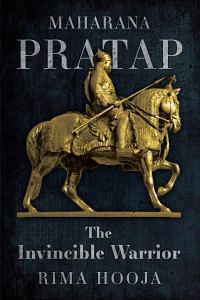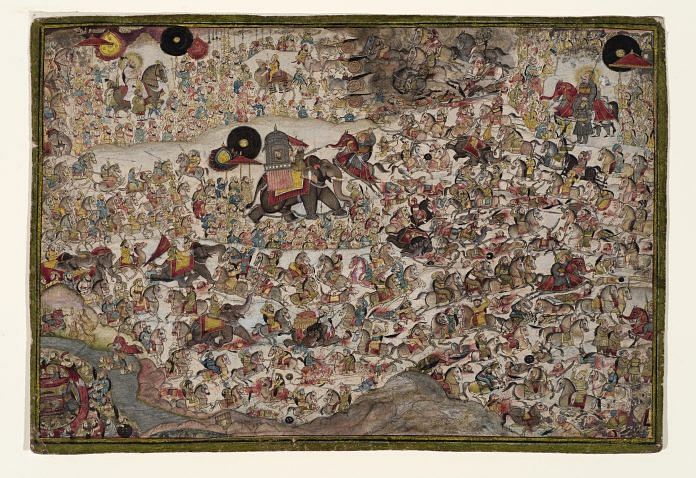Historian Rima Hooja in her book Maharana Pratap: The Invincible Warrior writes about how the king fought the Mughals for 20 years.
Post Haldighati, Akbar’s imperial Mughal forces further entrenched their positions in the plains of Mewar, where they already held mastery over Chittor, Mandalgarh and many other tracts. The roads into and out of Mewar were ‘closed’ by the Mughal forces. Maharana Pratap, however, continued to elude capture, and remained a powerful symbol of defiance.
Mewar’s warriors, having often experienced the drawbacks associated with long sieges, were willing to follow Pratap’s evolving policy that allowed for forts to be held, given up and retaken at opportune moments, with guerrilla warfare rather than pitched battles becoming part of his deliberate strategy. Another part of Pratap’s strategy was to encourage a loose coalition against the Mughals, especially with the states that ringed Mewar. The approach to Mewar necessitated crossing these kingdoms, and Pratap used his long-standing links with their rulers or chiefs to create buffer zones between the Mughals and Mewar.
Pratap specifically called upon Raja Narayan Das of Idar (who was also his father-in-law) to join hands with him against Akbar, supported Rao Chandrasen of Marwar in fighting Mughal garrisons in the Nadol area, and also influenced Rao Surtan of Sirohi and Taj Khan of Jalore to continue their resistance to Akbar. The latter two had reasserted their independence from the Mughals in the early months of 1576. However, partly to check Pratap’s attempts at finding support from like-minded neighbours, the Mughal armies redoubled their activities against the rulers of Sirohi and Jalore, and Chandrasen of Marwar. Akbar acted against all these allies of Pratap nearly simultaneously. He dispatched an imperial army under Tarsum Khan, Bikaner’s ruler Raja Rai Singh, and Syed Hashim Baraha to reduce them into submission. Taj Khan of Jalore was driven to surrender to Rai Singh of Bikaner. Sirohi’s ruler, Surtan, was humbled into presenting himself at Akbar’s court, though he later quit the court without permission (Bikaner’s Raja Rai Singh and others were thereafter deputed to deal with the Sirohi chief afresh). Another force was sent against Raja Narayan Das of Idar, and Idar was occupied after a stubborn resistance. Thus, Akbar succeeded in subduing Rao Surtan of Sirohi, Taj Khan of Jalore and Narayan Das of Idar. Nadol in Marwar too was captured by the Mughal forces by 19 October 1576, though Rao Chandrasen of Marwar continued to defy him.
Meanwhile, on 11 October 1576, four months after the battle of Haldighati, Emperor Akbar, leading a large army, had left Ajmer for Gogunda. The royal progress was far grander than the movement of previous expeditions against Mewar had been: the fluttering imperial pennants and banners visible from afar, and the dust raised by the feet of his cavalry, infantry and war elephants all but obscured the baggage trains and palanquins that brought up the rear. But for all the pomp of the imperial procession, Akbar moved fast, as had become his wont. Indeed, his rapid march of 400 kos, (around 965 km) in only nine days from Agra to Gujarat in 1573, to lift the siege of Ahmedabad by rebels like Mirza Muhammad Hussain and Ikhtiyar ul-Mulk, and going into battle immediately upon reaching Ahmedabad, had already become the stuff of legend. Once Akbar reached Gogunda, he took personal control of the campaign to bring Maharana Pratap to his knees, and gave orders for intense garrisoning and controlling of all the areas Pratap was rumoured to be in. Having personally inspected Mohi, near present-day Nathdwara, and appointed offi cers to guard and garrison it, he gave similar orders for Madariya, near Chittor. Numerous new Mughal outposts were established at places like Pindwara and Haldighati/Khamnor, and imperial officers put in charge of them. At around the same time, Akbar ordered Amber’s Raja Bhagwant Das, Man Singh, Qutb-ud-din and other senior imperial army commanders to pursue and capture the Maharana. In the period between his accession to the Mewar throne in early 1572 and the battle at Haldighati in June 1576, Pratap’s preparations towards what seemed an inevitable showdown with Akbar, had included – apart from building his military strength – consolidating his position in the hilly reaches of Mewar, and making the indigenous Bhils his partisans. As part of this strategy, he granted lands as jagir to local Bhils in Mewar’s hill regions. These preparations now served him well. All attempts on the part of the imperial forces to trace Pratap in the hilly reaches and difficult terrain of the more inaccessible parts of Mewar proved futile. For a while, the Maharana stayed at the village of Koliyari, to the west of Gogunda, to take stock of the situation and make further plans, but then, as was his habit, he moved on to another hideout.
 Excerpted with permission from Juggernaut.
Excerpted with permission from Juggernaut.




Maharana Pratap was a legendary hero for me. Dr. Hooja has added much to my romantic notions of his fighting Akbar’s forces. His spirit was indeed invincible. I look forward to reading the book.